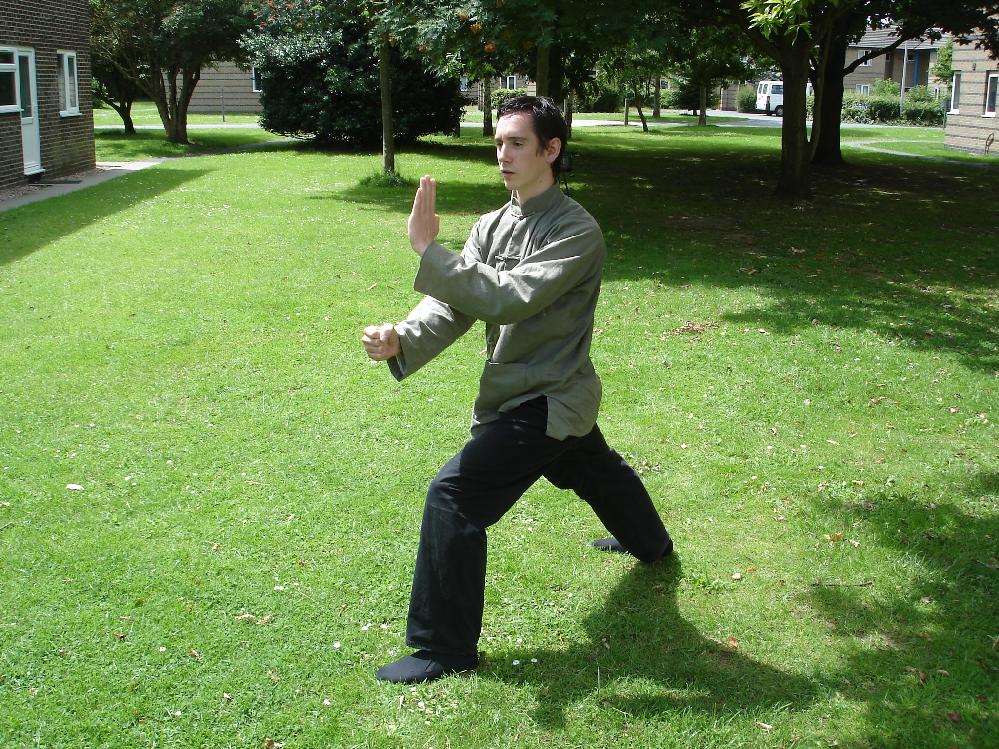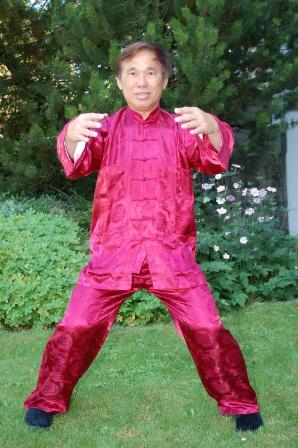CHI AND INTERNAL FORCE IN GENUINE, TRADITIONAL TAIJIQUAN
 Sifu Robin Gamble demonstrating a Taijiquan pattern called “Punch Below Sleeves” which would be ineffective in combat if the practitioner does not have internal force
Sifu Robin Gamble demonstrating a Taijiquan pattern called “Punch Below Sleeves” which would be ineffective in combat if the practitioner does not have internal force
The following discussion is reproduced from the thread What is Genuine, Traditional Taijiquan? started in the Shaolin Wahnam Discussion Forum on 5th June 2006.
"Terms like 'whole body force' and 'segmental force' may be excellent for external arts like Boxing and Wrestling, but inadequate to describe internal force in genuine, traditional Taijiquan.-- Sifu Robin Gamble
![]() Sifu Robin Gamble
Sifu Robin Gamble
Instructor, Shaolin Wahnam England
11th June 2006
Chi and Internal Force in Genuine, Traditional Taijiquan
The kind of force used in genuine, traditional Taijiquan is internal force, not muscular strength. And the core of force training in genuine, traditional Taijiquan is chi.kung, not hitting sandbags and lifting weights.
From what Kaitain has written, he does not believe in internal force and chi kung, and he emphasizes working on sandbags. From what he has shown in his videos, he uses muscular strength.
In direct contrast, Wahnam Taijiquan uses internal force, not muscular strength. And Wahnam Taijiquan practitioners use chi kung in their force training. We do not favour hitting sandbags and lifting weights.
Kaitain is fond of asking for proofs. While an honest attempt to verify is healthy, deliberating doing it to an extreme as in the case of Kaitain asking Siheng Kai to give the names of his opponents to prove that he (Kai) had won more than a hundred sparring competitions, or asking for proofs on generally accepted facts like Kaitain asking for proofs that “internal power” is used in Taijiquan, is a stubborn attempt to cover up ignorance.
I would not wish to waste time bringing in proofs that internal force is crucial in genuine, traditional Taijiquan, as it is a generally accepted fact. I am really surprised that despite his possession of 50 Taijiquan classics, Kaitain fails to notice that “internal force”, or “nei gong” in Chinese, is often mentioned in Taijiquan texts.
It is also a generally accepted fact that in genuine, traditional Taijiquan, physical size, age and sex are not determining factors in winning a combat. In other words, using genuine, traditional Taijiquan, a small-sized, elderly woman can beat a hefty young man. This, of course, shows the application of internal force.
The following are just a few of Kaitain's statements showing his ignorance of chi and internal force.
"I can hit people very hard and 'internally' (if you want to call it that - it's just good mechanics).""Show me a taijiquan classic that even uses the term Internal Power".
"Im using fa-jing in my video - it's whole body explosive power, utilising every joint all at once. There must be a coiling (collecting) of the body and a sudden release of that energy in one direction. Some styles train this in their form but I only train it on to a heavy bag or padded up partner (the padding is limited in effectiveness)."
"Fa-jing as a method is purely body mechanics."
(In response to Hubert asking what is chi or energy) "In physical terms it is potential force when collected and kinetic force when released."
I find it amusing that when commenting on my Sifu's performance of Wahnam Taijiquan, Kaitain said my Sifu used segmental force instead of whole body force.
This shows that Kaitain is not only ignorant of internal force in Taijiquan, he is also ignorant of the traditional terms used to describe force application in genuine, traditional Taijiquan.
Terms like 'whole body force' and 'segmental force' may be excellent for external arts like Boxing and Wrestling, but inadequate to describe internal force in genuine, traditional Taijiquan.
'Whole body force' gives the impression that the practitioner uses his whole body weight to back up his attack, such as a punch or a shoot. While this is effective in external arts like Boxing and Wrestling where weight and size are determining factors, in genuine, traditional Taijiquan, this is discouraged because, amongst other disadvantages, it makes it easier for the opponent to unbalance you, and it hampers your application of internal force.
Kaitain might have confused 'whole body force' with the concept of 'whole body movement' in genuine, traditional Taijiquan. When a Taijiquan practitioner explodes force, or fa-jing, for example, he may employ 'whole body movement', expressed in classical terms as 'starting from the back leg, controlled by the rotation of the waist, and explode in the hand'.This means that when a practitioner explodes force in Taijiquan, as demonstrated by my Sifu in the pattern “Single Whip”, the movement originates from his back foot, spirals up his legs, controlled by his waist, and the internal force channels from his dan tian through his body and arm, and explodes out in his palm as he strikes. Although it is a palm strike, the whole body is in motion.
This is the fundamental stage in exploding force, or fa-jing.
What is involved is not just all body mechanics, as Kaitain mistakenly claims, but energy flow. At an intermediate stage, while whole body movement is still used, the practitioner minimizes the movement, with the result that on-lookers may just see a slight twisting of his body as he strikes his palm. At the advanced stage, little body movement is used and the practitioner can explode much internal force at close range by just flexing his palm. This was probably what Kaitain saw in my Sifu's demonstration, and because of his ignorance he mistakenly called it 'segmental force'.

An important means to develop internal force in Taijiquan is to practice the Three-Circle Stance. This stance is demonstrated here by Grandmaster Wong.
-
1: Friendly Sparring?
-
2: And Now You Back Down
-
3: Shen-Fa or Body-Movement and Other Principles of Genuine, Traditional Taijiquan
-
4: Calling a Cow a Horse
-
5: The Reality of Chi and Internal Force
-
6: Could Yang Lu Chan Defeat Modern Ultimate Fighting Arts Fighters
-
7: Chi and Internal Force in Genuine, Traditional Taijiquan
-
8: It is Amazing some Instructors would Miss an Opportunity than Learn from another Master
-
9: On Principles, Stances, Force and Age in Taijiquan
-
10: In Genuine Kungfu, Size, Weight, Age and Sex are Not Decisive Factors in Combat
-
11: How to Improve your Mental Clarity
-
12: Boxing is Boxing, Taijiquan is Taijiquan
-
13: The Benefits Students Get from Kaitan's Taijiquan and from Wahnam Taijiquan
-
14: Harmonious Chi has a place Everywhere, and Internal Force is Real
-
15: Some Interesting Questions on Internal Force
-
16: Internal Force is an Essential Part of Genuine, Traditional Taijiquan
-
17: Is Kaitain's Taijiquan or Wahnam Taijiquan genuine, traditional Taijiquan
-
18: Cloud Hands, Silk Reeling and Grasping Sparrow's Tail
